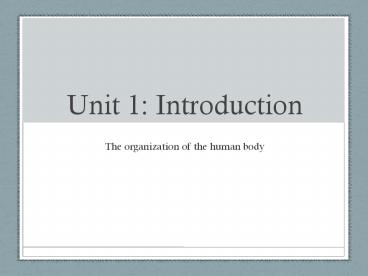Unit 1: Introduction - PowerPoint PPT Presentation
1 / 15
Title:
Unit 1: Introduction
Description:
Unit 1: Introduction The organization of the human body Anatomy and Physiology Anatomy = Structure Physiology = Function 5 Levels of Organization 1. – PowerPoint PPT presentation
Number of Views:174
Avg rating:3.0/5.0
Title: Unit 1: Introduction
1
Unit 1 Introduction
- The organization of the human body
2
Anatomy and Physiology
- Anatomy Structure
- Physiology Function
3
5 Levels of Organization
- 1. Cells
- 2. Tissues
- 3. Organs
- 4. Organ Systems
- 5. Organisms
4
How do you know something is alive?
- It needs energy
- It responds
- It moves
- It grows
- It differentiates
- It reproduces
5
Homeostasis
- Homeostasis is a condition of equilibrium or
balance in the body - Disruption of homeostasis can lead to disorders,
diseases, or death. - Aging is the result of the body being unable to
maintain homeostasis as effectively over time.
6
Anatomical Position
- Standing upright
- Facing forward
- Feet flat
- Arms at the sides
- Palms forward
7
Directional Terms
- Superior towards the head
- Inferior away from the head
- Dorsal at the back
- Ventral at the front
- Medial towards the midline
- Lateral away from the midline
8
Tissues
- Tissues are groups of cells with a similar
function - Histology is the study of tissues
- Pathologists are physicians who specialize in
studying diseases of tissues
9
4 Types of Tissue
- 1. Epithelial
- 2. Connective
- 3. Muscle
- 4. Nervous
10
Epithelial Tissue
- Epithelial tissue covers body surfaces, lines
hollow organs and body cavities, forms glands - Example skin
- Its the easiest to repair and replace
11
Connective Tissue
- Connective Tissue protects and supports the body
and its organs, holds organs together, and stores
fat - Example bone, cartilage
12
Muscle Tissue
- Muscle tissue is responsible for movement and the
generation of force - Example heart
13
Nervous Tissue
- Nervous tissue creates and sends signals
throughout the body - Example brain, spinal cord
- Its the hardest to repair/replace
14
Diseases and Disorders
- Please research the following diseases and
disorders of tissues. In your notebooks, record - the name of the disease,
- the cause,
- susceptibility (who is most likely to get it)
- the symptoms,
- the treatment/cure,
- and the consequences or prognosis.
- Diseases/Disorders
- Cancer
- Sjogrens Syndrome
- Lupus
- General Effects of Aging on Tissues
15
Introductory Project PromptGroups of 1-4
- Using 3D or 2D art as your media, each group will
be assigned a body system, and will create a
project that includes the following - The anatomy of the system (structure)
- The physiology of the system (function)
- The role it plays in maintaining homeostasis
- Each group will also submit a written component
(3 paragraphs) explaining how your project
addresses each component above. Due Tues/Weds
9/22 or 9/23































